Compiled by Geoff Goodall
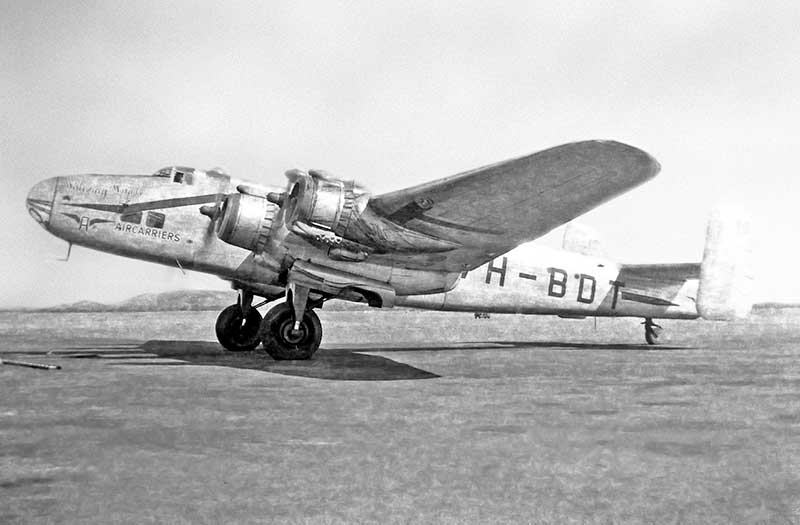
Aircarrier Pty Ltd's Halifax VH-BDT was outbound from Sydney to Singapore, on what was to be its sole revenue flight.
We are indebted to Ben Dannecker for saving the negative of this moment in time
Although the outbreak of war forced the closure of his civil aircraft business, Geoffrey Wikner worked closely with the RAF, which took over most of the Wickos for military communications duties under the name Warferry. Wikner flew with the Air Transport Auxilliary with the rank Flight Captain, making a total of 1,164 ferry flights between military units in 67 different types of aircraft up to B-24 and B-17 bombers. After V-E Day, aware that large numbers of RAF Halifax bombers were being retired, he approached the Ministry of Aircraft Production requesting the release of a Halifax which he would use for exhibition and fund-raising in Australia.
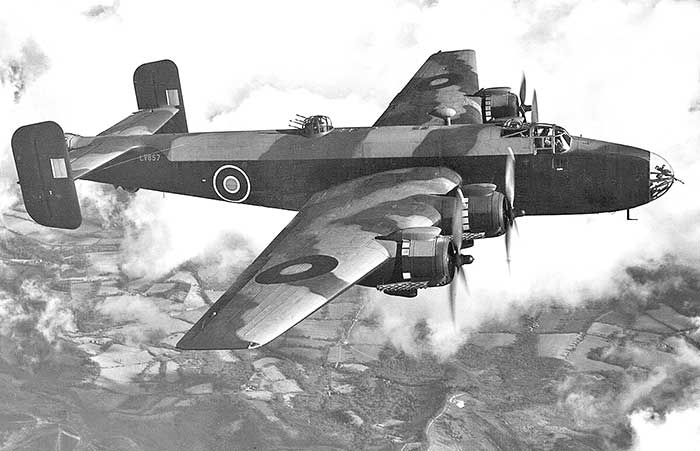
Meanwhile G-AGXA was completed, and in May 1946 Wikner was ready to depart. He later wrote:
"After nine frustrating months of seemingly endless red tape, during which the Air Ministry, the Foreign Office, Handley Page Ltd and the Bristol Aeroplane Company all tried to stop the flight from taking place. However, de Havillands very kindly overhauled the propellers free of charge, and Dunlops gave me a new set of tyres. Other companies kindly donated items free, including emergency rations. Shell organised the supply of fuel and I paid them £2,000 in advance. They did a very fine job and there were no hitches on their account. My flight was to be the first made to Australia in a privately-owned aircraft after the war, and I was up against it from the start.
I was told I could not use RAF aerodromes, although we were using the old RAF Transport Command routes. No maps of the route were available, but Transport Command kindly provided a manual which consisted mostly of radio aids and a few aerodrome maps. The aerodrome maps were not important - it was finding the aerodromes that mattered. Most of the flight was made using a Daily Telegraph map of the world and local knowledge gained from the staging posts as we proceeded."
Passengers were limited to 100 lbs of baggage each, which was stowed in the bomb bay. Wikner expected pre-war racing pilot Neville Stack to be copilot but Stack withdrew shortly before departure. One of the passengers was Miss Audrey Morgan, an ATA multi-engined pilot during the war, who gladly accepted the role as copilot. Other crew were engineer, navigator and radio operator.
The flight reached Sydney after many adventures and aircraft maintenance problems along the way. After arrival, Wikner was unable to gain sufficient backing for his planned Australian fund-raising tour. He requested permission from the British Ministry to sell the aircraft, and some time later it was purchased by Aircarriers Pty Ltd, a syndicate of former RAAF airmen. Registered VH-BDT, their optimistic plans failed after one revenue flight to Singapore, when the Halifax limped back to Sydney and never flew again.
Later in 1946 Geoffrey Wikner and his wife Trudy established the Halifax Caravan Park at Nelson Bay NSW and managed the business for the next twenty years.
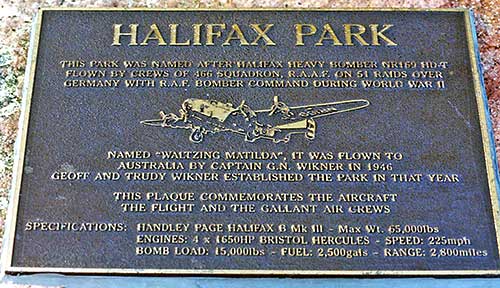
Aircarriers Pty Ltd, Sydney
Wikner managed to sell his Halifax to a group of Australian airmen
recently discharged from RAAF service and keen to continue in civil
aviation. A new company Aircarriers Pty Ltd was formed with the specific aim of operating G-AGXA as a commercial freighter.
The new company was established in Sydney by ex RAAF pilot Frank M. "Mac" Twemlow and RAAF fighter ace Clive R. Cadwell was closely involved in its formation. Caldwell was looking for post-war civil aviation ventures as Managing Director of established company Aerial Transport Ltd, Sydney. He was aware of the commercial potential of Wikner's Halifax parked idle at Mascot. In fact Caldwell had written to DCA as early as 30 August 1946 on Aerial Transport Ltd letterhead advising that the company planned to purchase G-AGXA and requested conditions under which DCA would allow it to be operated commercially as a freighter, or alternatively as a privately owned aircraft. In the latter case it would be used "as an Australian private aircraft used to carry personnel employed by Aerial Transport Ltd on regular overseas flights, to operate freely in the development of this company's business." He added that if they purchased the Halifax it must be capable of entering service by 20.9.46 to carry 20 employees to Japan (sic) to inspect and ferry six C-47s to Australia.
Wikner was keen to sell the Halifax. He sent a telegram to DCA on 24 September 1946 urgently requesting approval for G-AGXA to operate under its British CofA and CofR on a private flight from Sydney to Tokyo (sic) under the command of pilot Arthur Kell. Wikner will fly the aircraft to Brisbane, where he will facilitate Kell's endorsement. Nothing eventuated and on 10 October 1946 Wikner wrote to DCA thanking the Department for their assistance but advising that Caldwell had made other arrangements to transport his aircrews to Japan (sic) . See Note 1 below
Clive Caldwell had just signed a contract with The Zinc Corporation to acquire and deliver six Douglas C-47s from USAAF sales at Manila, Philippines. The Zinc Corp wanted them to support postwar expansion in mining across Australia. He had enlisted a group of recently demobilised RAAF pilots and fitters to prepare the Halifax which he would use to transport his men and supplies to Manila while preparing the C-47s. But Caldwell dropped the purchase when it became obvious that its certification as an Australian civil aircraft would be a lengthy process. He left for Manila to negotiate the purchase of the six C-47s. The party of ex military airmen followed to Manila to work on the selected C-47s and ferry them to Sydney, where they arrived on 4 December 1946. That same month Frank Twemlow's business in Sydney purchased G-AGXA and formed a new company to operate it commercially.
12.46 Aircarriers Pty Ltd was formed in Sydney as an associate of Gracelin Import and Export Co, Sydney which was owned by former RAAF pilot Frank "Mac" Twemlow
12.46 Purchased Halifax G-AGXA
30.1.47 Aircarriers Pty Ltd incorporated in NSW. Managing Director A.W. Ford, Directors W.W. Mabe, F.W. Twemlow, Pilot Captain F. M. Twemlow
2.47 Aircarriers arranged with Sydney commercial pilot H.W.G. (Warren) Penny, who was buying an ex RAAF Lockheed Hudson at Commonwealth Disposals Commission sales at RAAF Richmond, to purchase two additional Hudsons for them. In April 1947 Penny was advised that his bid for Hudsons A16-122, A16-147 and A16-149 was accepted and payment was due. At that time the principals of Aircarriers said they did not have the funds to pay for them. Penny resold their two Hudsons to his brother Raymond Penny who resold them
3.47 Aircarriers letters are on a printed letterhead "Aircarriers Pty Ltd - China-Australia via Java"
15.3.47 Halifax christened Waltzing Matilda in a ceremony at Bankstown Aerodrome by Mrs James McGirr, wife of the NSW Premier. Press reports stated the aircraft's pilot was Captain E. Hourigan and it would fly between Australia and China.
c3.47 Aircarriers were successful bidders for a Bristol Hercules Mk.IV engine serial No.4875 from Commonwealth Disposals Commission. The sale was recorded to Gracelin Import & Export Co Ltd, Sydney on behalf of Aircarriers Pty Ltd at the bid price £225.
No payment was received and the CDC later wrote to Aircarriers stating that the engine would be offered for resale with them responsible for any sale less than £225. A file memo 12.47 records that Aircarriers Pty Ltd was in liquidation
9.5.47 H.W.G (Warren) Penny was appointed a Director of Aircarriers Pty Ltd, but resigned from the board only 17 days later
5.47 Aircarriers were pressing DCA for a decision on approval to operate the Halifax commercially. A letter from the company stated they intend to fly the aircraft to China to survey air freight prospects, then to England to take crews to collect two Halton civil conversions of the Halifax
6.47 Halifax VH-BDT operated its only commercial flight, Sydney to Singapore carrying mixed cargo including live dogs in cages. Returned to Sydney empty after the return cargo of tyres and tubes was "improperly loaded" in Singapore, which caused takeoff problems. A Singapore DCA inspector ordered the cargo off-loaded. The Halifax crew protested but with limited personal funds and the company lacking local representation, were forced to return without the profitable payload which was to provide the profit for the flight.
5.7.47 VH-BDT returned to Sydney Airport on three engines. This was it last flight. Retired parked in the open at Mascot
17.7.47 Planned flight to depart Sydney for Hong Kong carrying company personnel was cancelled
29.7.47 Gracelin Export Company, operator of Halifax Waltzing Matilda joined with Australian airlines protesting in a series of newspaper reports over a sharp rise in airways facilities charges levied by DCA. Gracelin claimed they might be forced out of business by the charges
20.8.47 Aircarriers Pty Ltd was wound by by a Sydney Court Order. The company gave evidence that that it lost £900 on the flight to Singapore because the return was empty after the cargo was ordered to be off-loaded by the Singapore DCA. It had been improperly loaded which caused takeoff problems. The company was unable to pay DCA owned rent for a hangar and workshop at Bankstown Aerodrome and Director Frerick W. Twemlow had taken over the lease.
18.8.47 Liquidators of Aircarriers Pty Ltd advertised VH-BDT for sale in Sydney Morning Herald newspaper. Not sold.
8.10.47 Auction of Aircarriers Pty Ltd workshop equipment, tools, servicing gantries, Halifax tailwheel tow-bar, etc.
11.47 Mac Twemlow was engaged by Curtiss Madsen Aircrafts Pty Ltd, Sydney as pilot on their Lockheed Hudson VH-JCM.
The new company was established in Sydney by ex RAAF pilot Frank M. "Mac" Twemlow and RAAF fighter ace Clive R. Cadwell was closely involved in its formation. Caldwell was looking for post-war civil aviation ventures as Managing Director of established company Aerial Transport Ltd, Sydney. He was aware of the commercial potential of Wikner's Halifax parked idle at Mascot. In fact Caldwell had written to DCA as early as 30 August 1946 on Aerial Transport Ltd letterhead advising that the company planned to purchase G-AGXA and requested conditions under which DCA would allow it to be operated commercially as a freighter, or alternatively as a privately owned aircraft. In the latter case it would be used "as an Australian private aircraft used to carry personnel employed by Aerial Transport Ltd on regular overseas flights, to operate freely in the development of this company's business." He added that if they purchased the Halifax it must be capable of entering service by 20.9.46 to carry 20 employees to Japan (sic) to inspect and ferry six C-47s to Australia.
Wikner was keen to sell the Halifax. He sent a telegram to DCA on 24 September 1946 urgently requesting approval for G-AGXA to operate under its British CofA and CofR on a private flight from Sydney to Tokyo (sic) under the command of pilot Arthur Kell. Wikner will fly the aircraft to Brisbane, where he will facilitate Kell's endorsement. Nothing eventuated and on 10 October 1946 Wikner wrote to DCA thanking the Department for their assistance but advising that Caldwell had made other arrangements to transport his aircrews to Japan (sic) . See Note 1 below
Clive Caldwell had just signed a contract with The Zinc Corporation to acquire and deliver six Douglas C-47s from USAAF sales at Manila, Philippines. The Zinc Corp wanted them to support postwar expansion in mining across Australia. He had enlisted a group of recently demobilised RAAF pilots and fitters to prepare the Halifax which he would use to transport his men and supplies to Manila while preparing the C-47s. But Caldwell dropped the purchase when it became obvious that its certification as an Australian civil aircraft would be a lengthy process. He left for Manila to negotiate the purchase of the six C-47s. The party of ex military airmen followed to Manila to work on the selected C-47s and ferry them to Sydney, where they arrived on 4 December 1946. That same month Frank Twemlow's business in Sydney purchased G-AGXA and formed a new company to operate it commercially.
12.46 Aircarriers Pty Ltd was formed in Sydney as an associate of Gracelin Import and Export Co, Sydney which was owned by former RAAF pilot Frank "Mac" Twemlow
12.46 Purchased Halifax G-AGXA
30.1.47 Aircarriers Pty Ltd incorporated in NSW. Managing Director A.W. Ford, Directors W.W. Mabe, F.W. Twemlow, Pilot Captain F. M. Twemlow
2.47 Aircarriers arranged with Sydney commercial pilot H.W.G. (Warren) Penny, who was buying an ex RAAF Lockheed Hudson at Commonwealth Disposals Commission sales at RAAF Richmond, to purchase two additional Hudsons for them. In April 1947 Penny was advised that his bid for Hudsons A16-122, A16-147 and A16-149 was accepted and payment was due. At that time the principals of Aircarriers said they did not have the funds to pay for them. Penny resold their two Hudsons to his brother Raymond Penny who resold them
3.47 Aircarriers letters are on a printed letterhead "Aircarriers Pty Ltd - China-Australia via Java"
15.3.47 Halifax christened Waltzing Matilda in a ceremony at Bankstown Aerodrome by Mrs James McGirr, wife of the NSW Premier. Press reports stated the aircraft's pilot was Captain E. Hourigan and it would fly between Australia and China.
c3.47 Aircarriers were successful bidders for a Bristol Hercules Mk.IV engine serial No.4875 from Commonwealth Disposals Commission. The sale was recorded to Gracelin Import & Export Co Ltd, Sydney on behalf of Aircarriers Pty Ltd at the bid price £225.
No payment was received and the CDC later wrote to Aircarriers stating that the engine would be offered for resale with them responsible for any sale less than £225. A file memo 12.47 records that Aircarriers Pty Ltd was in liquidation
9.5.47 H.W.G (Warren) Penny was appointed a Director of Aircarriers Pty Ltd, but resigned from the board only 17 days later
5.47 Aircarriers were pressing DCA for a decision on approval to operate the Halifax commercially. A letter from the company stated they intend to fly the aircraft to China to survey air freight prospects, then to England to take crews to collect two Halton civil conversions of the Halifax
6.47 Halifax VH-BDT operated its only commercial flight, Sydney to Singapore carrying mixed cargo including live dogs in cages. Returned to Sydney empty after the return cargo of tyres and tubes was "improperly loaded" in Singapore, which caused takeoff problems. A Singapore DCA inspector ordered the cargo off-loaded. The Halifax crew protested but with limited personal funds and the company lacking local representation, were forced to return without the profitable payload which was to provide the profit for the flight.
5.7.47 VH-BDT returned to Sydney Airport on three engines. This was it last flight. Retired parked in the open at Mascot
17.7.47 Planned flight to depart Sydney for Hong Kong carrying company personnel was cancelled
29.7.47 Gracelin Export Company, operator of Halifax Waltzing Matilda joined with Australian airlines protesting in a series of newspaper reports over a sharp rise in airways facilities charges levied by DCA. Gracelin claimed they might be forced out of business by the charges
20.8.47 Aircarriers Pty Ltd was wound by by a Sydney Court Order. The company gave evidence that that it lost £900 on the flight to Singapore because the return was empty after the cargo was ordered to be off-loaded by the Singapore DCA. It had been improperly loaded which caused takeoff problems. The company was unable to pay DCA owned rent for a hangar and workshop at Bankstown Aerodrome and Director Frerick W. Twemlow had taken over the lease.
18.8.47 Liquidators of Aircarriers Pty Ltd advertised VH-BDT for sale in Sydney Morning Herald newspaper. Not sold.
8.10.47 Auction of Aircarriers Pty Ltd workshop equipment, tools, servicing gantries, Halifax tailwheel tow-bar, etc.
11.47 Mac Twemlow was engaged by Curtiss Madsen Aircrafts Pty Ltd, Sydney as pilot on their Lockheed Hudson VH-JCM.
At that time Australian airlines were in commercial competition to acquire C-47s from the large numbers being sold by the US Foreign Liquidation Commission at Manila. However profiteering and black-market tactics required worldly negotiators - at least one Australian airline proprietor went to Manila to purchase aircraft but was unable to get past US military middle men, so returned home without the Beech C-45s he intended to purchase.
Former RAAF wartime hero, fighter ace Group Captain Clive "Killer" Caldwell DSC was involved in the Morotai Mutinee in April 1945 when senior officers submitted their resignations in protest at RAAF command decisions that they believed wasted their squadrons and endangered their pilots. Retribution came with his Court Martial in January 1946 on charges of selling alcohol flown from Australia on RAAF Dakota courier flights to US forces at Morotai. Caldwell was demoted to Flight Lieutenant and immediately left the Air Force.
He joined Sydney businessman G.B.S. Falkiner's small pre-war business Aerial Transport Ltd which dealt in light aircraft sales. Caldwell soon negotiated a deal with The Zinc Corporation which wanted to import six C-47s to be based at Broken Hill NSW to support the Australian mining industry. Caldwell went to Manila where he purchased six C-47s and 5 Stinson L-5s and recruited 20 Sydney aircrew to prepare them and ferry them back to Australia, the Stinsons were carried dismantled in the C-47s.
Caldwell led his six C-47s in USAAF camouflage back to Australia, reaching Sydney on 4.12.46. The Stinson Sentinels were given civil overhauls and sold to private owners by Aerial Transport Ltd. After this adventurous start, Caldwell saw few other civil aviation business opportunities in the post-war economy and decided to move on to a new career dealing in fabrics.
| 44 | Built by English Electric Ltd under wartime sub-contracted production, to an Air Ministry order for 200 Halifax B.Mk.IIIs allocated serials NP930 to NR290 (with serial "blackout blocks") Powered by four 1,615hp Bristol HErcules 16s |
| 18.10.44 | Taken on RAF charge as Halifax B.III NR169 |
| 18.10.44 | Delivered to RAF No.466 (RAAF) Squadron, based at RAF Driffield. Squadron code "HD-T" |
| 4.45 | Last operation with 466 Squadron. NR169 flew a total of 51 raids by the Australian crews of 466 Sqn |
| .45 | Retired, stored at RAF High Ercall pending disposal |
| 2.11.45 | Sold through Ministry of Aircraft Production to Geoffrey N. Wikner Wickner wrote that he selected this aircraft from those available because it had the lowest engine hours since last overhaul |
| 4.1.46 | Registered G-AGXA: Geoffrey N. Wikner, The Round House, Romsey, Hants |
| 2.46 | Ferried
to Radlett aerodrome, Herts for passenger conversion by Handley Page
Ltd, including modifications designed by Wikner. All armour plating
was stripped and canvas seating provided for 15 passengers with lap
straps. Crew stations were captain, copilot, navigator, radio-operator,
flight engineer |
| 20.2.46 | Inspection
by Bristol Aeroplane Co and Handley Page Ltd
to submit quotes for the cost of rectifying faults to prepare the
aircraft for issue of a civil CofA. Wikner had an acrimonious
dispute with Handley Page over the charges levied for work carried out.
He later wrote that he felt
that both companies quoted unfairly high prices, taking advantage of
his desire to depart as soon as possible. In the event the majority of work was carried out by Cunliffe Owen Aircraft, which was an experienced wartime Halifax overhaul contractor. |
| Civil registration was painted in white over the night camouflage, and name Waltzing Matilda on the nose. "Halifax Exhibition Flight in aid of RAF Benevolent Fund and RAAF Welfare Fund" painted on fuselage | |
| Geoffrey
Wikner advertised in the British press for fellow Australians wanting
to return home and prepared to pay to cover the costs
for his flight to Sydney. He wrote that after receiving almost a
hundred letters, he and his wife took considerable time sorting and
contacting the applicants | |
| 14.5.46 | Flown for Air Registration Board inspection |
| 16.5.46 | British Restricted CofA issued as a 20 seater transport with 15 passenger seats |
| 25.5.46 | Wickner made his final handling flight in G-AGXA |
| 26.5.46 | Departed
Hurn Airport, Bournemouth for Australia, under the command of Geoffrey
Wikner. On board, including crew, were a total of 9 men, 10 women and 3 children |
| The stops were Marseilles, RAF Castel Benito (Tunis), Cairo, Basra, Sharjah, Almaza, Jodhpur, Calcutta, RAF Pegu (Burma), Bangkok, RAF Changi (Singapore), Balikpapan, Darwin, Cloncurry, Sydney | |
| 15.6.46 | G-AGXA arrived at Mascot Airport, Sydney at 3.40pm local time. The flight from England had taken 73 hrs 27mins flying time |
| Australian
Customs levied duty on the import of the aircraft. Wikner refused to
pay and Customs advised the Department of Civil Aviation that G-AGXA
must not depart Mascot without their approval | |
| G-AGXA was left parked in the weather at Mascot | |
| Despite
extensive efforts, Geoffrey Wikner was unable to raise support for his
planned fund-raising exhibition tour of Australia with the Halifax,
which retained its Australian squadron markings of 51 tours. He
offered it to RAAF for training and as a gift
to the Australian War Memorial in Canberra, but both declined. He
British Ministry of Aircraft Production granted him permission to sell
the aircraft on condition that the sale was not to a foreign government. | |
| 12.46 | Purchased by Aircarriers Pty Ltd, 183 Castlereagh Street, Sydney NSW |
| 12.46 | DCA Mascot office advised
Head Office that G-AGXA had been purchased from Wikner by a concern
named Aircarriers Pty Ltd, who plan to operate the
aircraft for freight. Their initial work would be: - remove the mid-upper and rear gun turrets and fair over the openings - remove the H2S Radar blister from the lower fuselage and install a detachable cover |
| 11.12.46 | Geoffrey
Wikner, address now Halifax Park, Nelson Bay NSW wrote to DCA advising that he had
sold G-AGXA to Mr. A. W. Ford trading as Aircarriers Pty Ltd |
| DCA sought advice from the British Air Registration Board to clarify the CofA status of G-AGXA. ARB advised that it had approved Wikner flying the aircraft without compliance with a full British CofA on the clear understanding that it as for private use only, for the flight to Australia. The ARB was aware that Wikner had objected to the costs of civil conversion charged by Handley Page and commented "the difficulties which arose between Handley Page and the owner make it doubtful whether the firm themselves were wholly satisfied with the condition of the aircraft." | |
| A detailed response from the British Ministry of Civil Aviation clarified further: - G-AGXA is a Halifax Mk.3 with Hercules 16 engines - The only Halifax model approved for public transport is the Halifax Mk.8 with Hercules 100 engines - Handley Page has advised MCA that the company is not prepared to investigate G-AGXA to determine the standards required to satisfy a public transport CofA | |
| 21.5.47 | Aircarriers Pty Ltd letter to DCA signed by W.W. Mabe (Director):
following discussions between Aircarriers director Mr. Warren Penny and
the Department, the company now wishes to apply for an extended CofA
for G-AGXA to allow it to commence commercial operations. |
| 5.47 | DCA
internal correspondence acknowledged that Aircarriers had carried out
considerable work on the aircraft to remove all military fittings and
bring it up to airworthy condition. |
| 21.5.47 | Australian Registration Application form submitted to DCA by Aircarriers Pty Ltd. Base of the aircraft would be Bankstown Aerodrome, Sydney |
| 5.6.47 | DCA
replied to Aircarriers stating only a Private Category CofA could be
considered, due to the advice received from British Ministry of Civil
Aviation. Aircarriers would have to approach the Handley Page company
to make the necessary design information available to determine
suitability for an unrestricted Australian CofA |
| 17.6.47 | Temporary 3 month Australian CofA issued for Private operations only |
| 17.6.47 | Added to Civil Register VH-BDT: Aircarriers Pty Ltd, P.O.Box 8, Bankstown Aerodrome, Sydney |
| 6.47 | The
company's first
charter flight was from Sydney to Singapore with a mixed cargo
including 89 live dogs in cages. This
was in response to high prices being paid for guard dogs during to a
post-war crime wave in Singapore. The local dog population had been
eliminated during the wartime Japanese occupation, when dogs provided
food for the civil populace. A Sydney freight forwarding company arranged the load, which was nominally owned by Aircarriers Pty Ltd director Mr. F.W.Twemlow, which made the flight to Singapore a Private operation |
| 6.47 | VH-BDT
departed Sydney for Singapore, under command of Australian Captain
Edmund L. "Ted" Hourigan, who had flown in RAF Bomber Command during
the war. |
| Arrived at Singapore. Reported to have used RAF Tengah | |
| 29.6.47 | Attempted departure
Singapore for Australia, carrying several passengers associated with
the company and a freight consignment of 15,000 motor tyres and tubes
listed on the manifest as owned by the company. Captain Hourigan was unable to lift the tail during the first takeoff run and returned to the parking area where the crew redistributed the load. A second takeoff was commenced, but aborted when the tailwheel tyre burst on the runway. Singapore DCA inspector ordered the cargo to be off-loaded, incorrectly reporting that the tail wheel had "collapsed" due to the weight of the cargo. The Halifax crew protested but with limited personal funds and the company lacking local representation, were forced to return without the profitable payload. A subsequent Australian DCA investigation found that the Halifax Load Chart approved for Aircarriers Pty Ltd was satisfactory and that the tailwheel tyre failure was not due to the weight of the aircraft |
| 2.7.47 | Departed Singapore for Australia without cargo. |
| An
additional crew member on return flight to Sydney was Sydney commercial
pilot Gregory R.Board, who was listed as "copilot". Board had just
flown an Avro Anson VH-ARK from Sydney to Singapore hiding a Sydney
criminal on board who had paid to escape from Australian police. Board
sold the Anson in Singapore, then was looking for a lift home to
Sydney. See Avro Anson Part 1 on this site. | |
| Delayed at Balikpapan, Borneo with engine trouble | |
| 5.7.47 | Returned to Sydney with one engine shut down and propeller feathered. This was the aircraft's last flight |
| 7.47 | Retired at Sydney Airport, parked in the open. |
| 18.8.47 | Liquidators of Aircarriers Pty Ltd advertised VH-BDT for sale in Sydney Morning Herald newspaper |
| 12.47 | Damaged by vandals who broke into the aircraft while retired in the open at Mascot. LAMS Halifax G-AIWK Port of Sydney was also damaged by vandals 8.12.47 but repaired: see below |
| 19.7.48 | Mr. A. Chapman, Bonnyrig via Liverpool NSW wrote to DCA requesting allocation of a hangar at Bankstown Airport. He wrote "I
have aircraft tied up in other states because of the lack of
hangarage....I am taking delivery of an Airspeed Envoy on the 26th of
this month. I will be taking delivery of the Halifax Mark III at
Mascot about that period too." Nothing is known about Mr. Chapman, but the Envoy must have been the Ansett Airways VH-UXM retired at Melbourne-Essendon. Curiously, in November 1947 it had been advertised for sale in the Sydney Morning Herald newspaper by Sydney company Macair Charter Service "excellent for charter work, 6 passengers, just completed CofA. Many spares held including spare engine" (Whether Macair had purchased the aircraft is not known, but this Envoy was parked in the open at Essendon for some time in 1948-1949, still apparently owned by Ansett Airways until broken up) |
| 28.7.48 | Sale
documents: "Sale 28.7.48 Sheffield Grinding and Salvage Co: £100 for Halifax aircraft Waltzing Matilda as it stands at Mascot Aerodrome." |
| 48 | Broken-up for scrap at Mascot Airport |
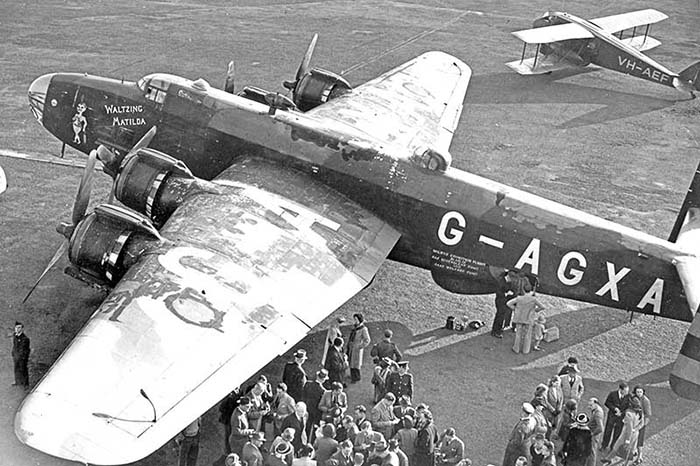
A Butler Air Transport Dragon taxies past. Photo: John Hopton Collection
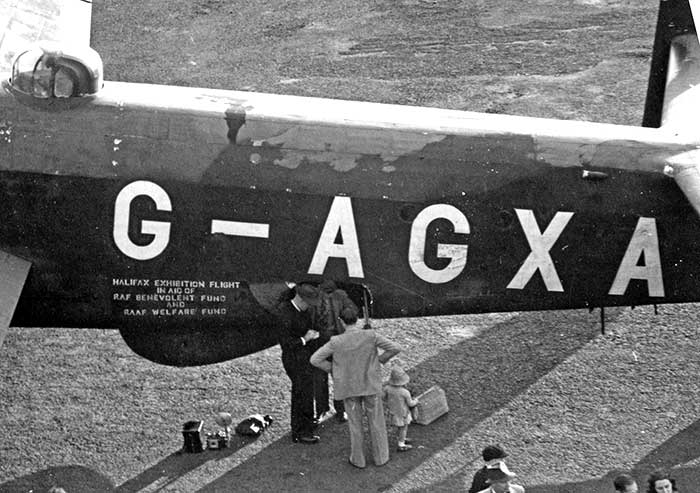
John Hopton Collection
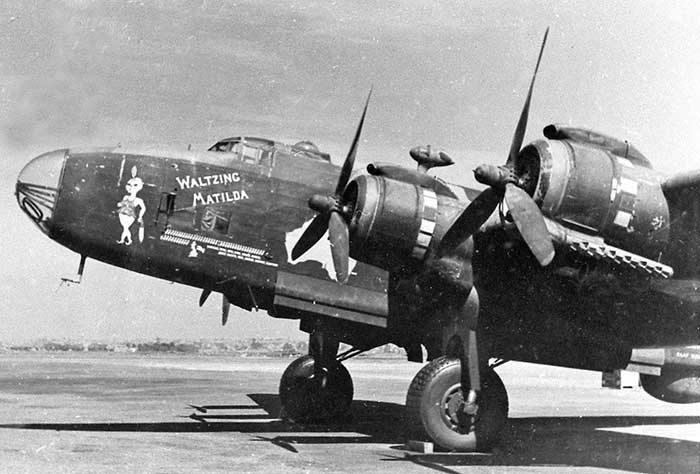
The aircraft retained the 466 Squadron wartime nose art indicating 51
raids. John Hopton Collection
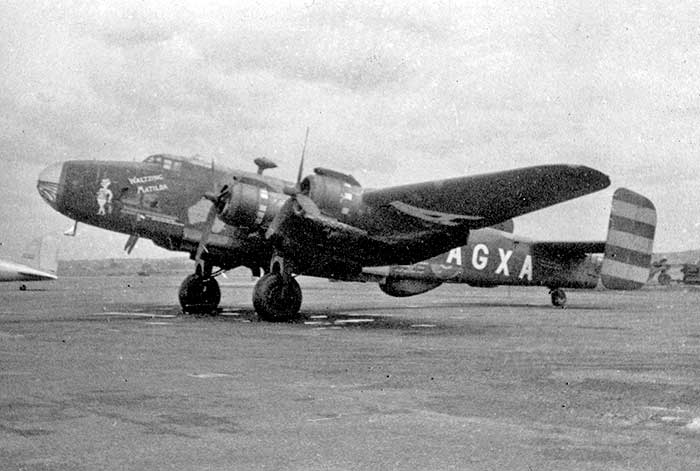
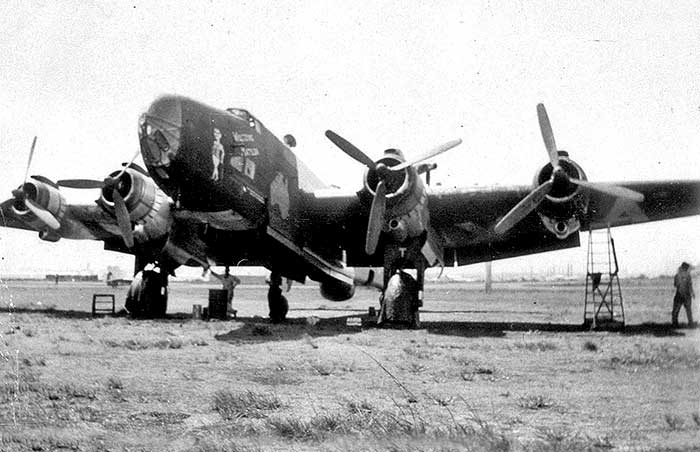
and preparing the Halifax for commercial freight service. Photo: State Library of NSW

Note the long crew ladder under the nose. John Hopton Collection
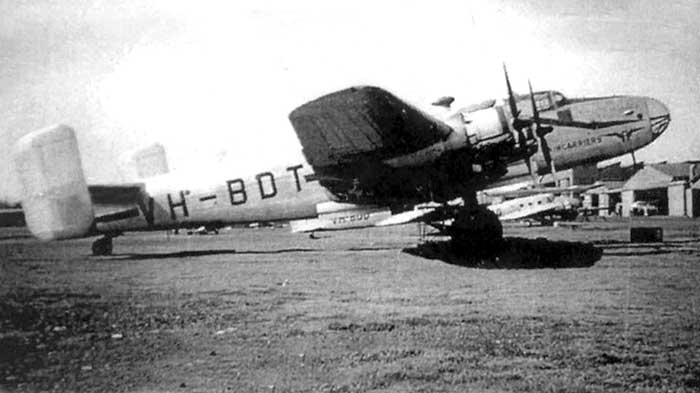
London Aero and Motor Services Ltd, Stansted, England
LAMS Australia Ltd, Sydney
LAMS Australia Ltd, Sydney
Halifaxes were registered in France, South Africa, Pakistan and India. The British Halifax charter operators developed contracts for the fast transport of ships crews, carrying machinery to Africa, pilgrims to Mecca and bringing fresh fruit and textiles to Britain from Italy and Spain. They also had a prominent role in the Berlin Airlift 1948-49, when a total of 41 Halifaxes were used, carrying 6 tons payloads including bulk coal, with some fitted to carry oil and diesel fuel.
The end of the Berlin Airlift marked the end of the Halifax in civil service. Shipping services had improved and the post-war airfreight boom had collapsed. A number of the British civil Halifaxes were clandestinely delivered to the Egyptian Air Force as paratroop transports.
Formed in early 1946 by a London West End car hire service business, Grosvenor Square Garages. LAMS Managing Director Doctor Graham Humby was convinced that a tramping air freight network would be viable, given the massive amounts of freight held up in ports world-wide because shipping had not recovered from war losses and military loadings were given priority. Humby was an enthusiastic and wealthy man, referred to by the British press as The Flying Millionaire, who refused to continue as a doctor under the new British nationalised health scheme, turning instead to aviation.
Humby purchased six recently-retired RAF Halifax C.Mk.8 transports fitted with large belly freight panniers. They were only a year old and required minimal expense for civil certification. LAMS painted its Halifaxes all blue with white registration letters and company insignia on the nose, with individual aircraft named after ports on the planned route network. The first G-AHZN entered service 27 August 1946 and intial freight work to the Continent and Africa confirmed Humby's optimism. In December that year LAMS moved from Elstree to its specialised freight hub at Stansted Airport, and 10 more Halifaxes acquired. By April 1947, the blue LAMS Halifaxes were importing 500 tons of fruit a month into Britain from Europe, and Dr. Humby had enough aircraft capacity to commence his plan for world-wide unscheduled tramping operations.
As a trial, G-AIWT Port of Sydney departed Stansted on 23 April 1947 on an around-the-world tramping flight. Under the command of LAMS Chief pilot Captain Keith Thiele, with Graham Humby listed as copilot, the Halifax routed via Iceland, Montreal, New York, San Francisco, Honolulu, Canton Island, Fiji, New Zealand. The load from Fiji to Auckland was 2.5 tons of empty beer bottles to help a bottle shortage at the Auckland brewery which supplied Fiji. Then to Sydney and return to England, reaching Stansted 4 June 1947 carrying 7 tons of dripping, which was in short supply in Britain.
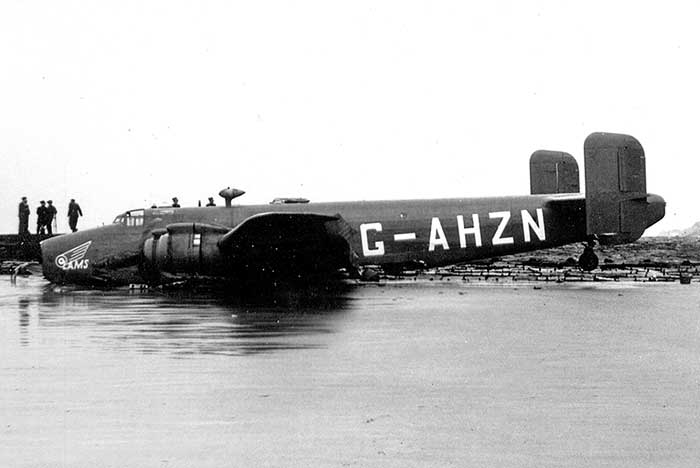
All blue LAMS Halifax G-AHZN "Port of London" was ditched on the Belgian coast on 26 September 1946
due to low fuel after navigation difficulties enroute Milan to London carrying crates of Italian grapes.
Photos: Ian Simpson via Derek King
due to low fuel after navigation difficulties enroute Milan to London carrying crates of Italian grapes.
Photos: Ian Simpson via Derek King
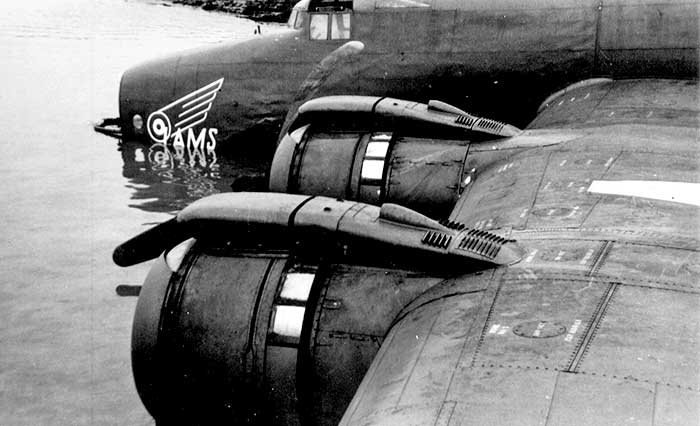
LAMS Australia Pty Ltd
Associate companies LAMS (Africa) Ltd and LAMS Australia Pty Ltd
were established, to organise local freight consignments.Doctor Humby sent his Stansted Airport Manager Sqn Ldr W. H. "Vince" Furlong to Sydney as Manager of LAMS Australia Pty Ltd. The South African subsidiary began well, but the enthusiastic Humby did not anticipate the Australian Government's crushing protectionism of nationalised Qantas Empire Airways, decreed as "the chosen instrument" for overseas air services. Competitors such as Bryan Monkton's Trans Oceanic Airways ran into the same obstructionism.
Australian Government internal correspondence discussing LAMS Australia's planned tramp freighting operations reveal a perplexed attitude that such unscheduled flights would thwart bureaucractic regulation. The solution was to demand that LAMS must submit full details of load manifest for each flight to Department of Civil Aviation for specific approval. The details would require proof of prices being charged for air freight items to ensure it was not below Qantas freight rates, despite Qantas having little air freight capacity at that time. In addition, DCA sent telegrams to LAMS on the day of departure requiring declaration that the crew included a Radio Operator with First Class Telephony rating and a licenced Navigator.
On 15 October 1947, LAMS Australia Pty Ltd's Manager W. H. Furlong decided to take the initiative after waiting 4 months for a written response from the Director General Civil Aviation to his two hour interview with Dr. Humby in May. Furlong wrote a long letter to DGCA setting out the company's plans to commence Halifax tramp freight flights at Schofieldsin November. He had personally gained approval from RAAF Commanding Officer at Schofields for tarmac space and buildings to base 6 to 10 Halifaxes at Schofields. LAMS will sell seats for passengers also, offering a free baggage allowance of 100 lbs per passenger. The tone of the letter was a statement of what his company was going to do, rather than a subservient request for bureaucratic approval. Reaction was swift:
- DCA instructed LAMS to supply its airline schedules to Australia for the next 12 months. This received the predictable response that freight
tramping operations do not run to a schedule, but instead when a load is ready.
- Collector of Customs wrote to LAMS stating that Sydney Airport is the designated International Airport and Customs will not approve flights at
Schofields. LAMS replied that it was aware that RAAF arrivals at Schofield are routinely cleared by Customs staff travelling from Sydney Airport for
each arrival. Customs did not respond.
- Qantas Empire Airways wrote to LAMS Australia bluntly advising that because LAMS is advertising air freight rates below Qantas rates, use of Qantas
facilities or staff at any airports en route is withdrawn.
- The Sydney freight-forwarding business contracted to LAMS was reprimanded by Government agencies over its advertised freight rates using LAMS services.
While the DGCA and the Minister considered the situation with
increasing irritation, a few LAMS (Australia) flights in November and
December 1947 were each granted DCA approval. However an event on the
other side of the world would soon bring the entire LAMS operation to
an unexpected end.
In late 1947, with a
fleet of 18 Halifaxes and LAMS seemingly facing a bright world wide
future, Managing
Director Graham Humby was visiting Boeing in Seattle to discuss
Stratocruiser orders. He became ill and was admitted to hospital in USA
and diagnosed with severe tuberculosis. He was forced to withdraw from
the management of LAMS, but without his
dynamic authority the operation soon floundered. By February 1948
most of
the fleet was idle at Stansted, staff and pilots unpaid. In July 1948
LAMS was compulsorily wound up.The following is a time-line of LAMS operations in Australia:
Auckland-Sydney record time set by a Pan American Douglas DC-4. LAMS Managing Director Graham Humby was on board.
16.5.47 Graham Humby arrives Sydney, keen to promote his plans for Australia. The next morning's Sydney Morning Herald newspaper reported his
arrival in one of his own Halifax freight aircraft:
"He came to inaugurate a new branch of London Aero Motor Services Ltd, an English air freight service. Dr Humby said he refused to practice
as a doctor under the British nationalised medical system and was now concentrating on the establishment of a Pacific freight service, which
would extend as far as India, Japan and America using 4 engined Halifax planes. He hoped to have the Pacific branch in operation in three
months. 'We are out to beat the Americans' Dr Humby said. 'There are rich pickings in the Pacific and we can undercut any of our competitors'.
The planes would be flown largely by Australians and Sydney would be their headquarters."
20.5.47 Graham Humby had a two hour interview with the Australian Department of Civil Aviation Director General, Air Marshall Richard Williams at DCA
Head Office, Melbourne. He explained that LAMS is establishing a world-wide tramp freighting air service. London Airport is unsuitable for freight
and the Ministry has allowed him to set up a freight base at Stansted where he is taking over sections as the RAF withdraws from the airfield.
Humby submits that Schofields military airfield, which is a similar distance from Sydney as Stansted is from London would be a suitable base
for his Australian business. He requested DCA support for his dealings with the Australian military authorities to allow LAMS to lease a section
of Schofields and operate from there.
27.5.47 G-AIWT departed Sydney on return to Britain, carrying 7 tons of food including drums of dripping, which were the results of a
Food For Britain Fund. Press photographs show the loading at Mascot with banners proclaiming Best Wishes from New South
Wales Australia. G-AIWT arrived back at Stansted 4.6.47.
4.9.47 LAMS press release published in Australian newspapers: LAMS will base six Halifax freighters "at an airfield which the company has acquired
near Sydney". The Sydney operation will commence in October 1947 to carry freight to New Zealand, China, Japan, Netherlands East Indies and
the west coast of USA
9.47 LAMS (Australia) Pty Ltd employed Captain Ted Hourigan as its first Australian pilot. He had been pilot for Aircarriers Pty Ltd's Halifax VH-BDT
but Aircarriers now in liquidation. While waiting for Australian operations to commence, Hourigan was sent to LAMS in England on board a
visiting company Halifax, and crewed Halifax flights between England and South Africa
9.10.47 Director General of Civil Aviation Williams (DGCA) finally responds to a series of LAMS letters and cables, following his May 1947 personal
meeting with Dr.Humby:
- He is concerned that the proposed LAMS operation will take air freight from "the established regular services"
(compiler's note: ie. Qantas Empire Airways, nationalised that year by the Australian Government and protected as the
Government's so-called chosen instrument for overseas air services)
- He will not allow LAMS to carry into Australia any freight that could be carried by established regular air services. Each LAMS flight would
need prior DCA approval based on its individual manifest and circumstances
- Revenue flights within Australia will not be approved
- Use of Schofields Aerodrome was doubtful because of Australian military requirements
- He warns that aviation petrol restrictions in Australia are probable due to the US dollar shortage and helpfully suggests that the
company reconsider their Australian plans
15.10.47 LAMS Australia Pty Ltd Manager Sqn Ldr W. H. Furlong wrote to DGCA advising that his company has successfully negotiated with the RAAF
for access for the LAMS freight operation at Schofields. He has been allocated hard-standing parking for 6 to 10 Halifaxes and use of vacated
RAAF buildings. His Australian company plans to commence operations in November 1947 with the first departure to Britain scheduled for
18.11.47 on which they will sell seats for passengers also, offering a free baggage allowance of 100 lbs per passenger.
10.47 This letter causes consternation at highest levels of DCA, generating numerous memos, letters and cables between DGCA, Minister for Air,
Australian Customs, RAAF, Qantas Empire Airways, Department of External Affairs.
15.10.47 G-AIWK Port of Sydney scheduled to depart Britain for Australia. The original Port of Sydney G-AIWT had crashed at
Bovingdon 5.9.47 and the name transferred to G-AIWK
3.11.47 G-AIWJ Port of Athens arrived Sydney Airport at 11am from Britain via Darwin. Captain K.F.Thiele.
18.11.47 G-AIWJ scheduled to depart Sydney for Britain. Route via Cloncurry, Datwin, Soerabaja, Singapore. Captain Zablocli.
The entire capacity of the aircraft had been chartered by freight forwarders Messrs Birt & Co, Sydney
18.11.47 G-AIWK scheduled to depart Sydney for Manila, chartered by the Philippine Government to carry mixed live poultry.
Captain K. F. Thiele. Route was Sydney-Brisbane where it was loaded, then Cloncurry, Darwin, Morotai, Manila
22.11.47 Halifax G-AIHU Air Adventurer arrived Darwin from Sourabaja. Departed next day for Sydney. Cargo flight operated by LAMS.
The aircraft was leased from Lancashire Aircraft Corporation for this trip. This was probably the LAMS flight reported in the press as departing
London 15.11.47 for Sydney carrying a large consignment of biro pens for the Australian Christmas sales rush. On arrival it was found that
many of the biro pens had leaked ink due to the changing cabin air pressure en route.
(G-AIHU crashed in England 5.12.47 only a few days after returning from Australia)
8.12.47 G-AIWK was damaged by vandals while parked at Sydney Airport. Damage estimated at £150 was repaired.
(Australian Halifax VH-BDT retired nearby was also damaged at the same time)
23.12.47 G-AIWK flew Sydney to Auckland-Whenuapai (6 hrs 20 mins) carrying 7,500 Queensland pineapples which arrived in good condition.
Captain K. F. Thiele. Returned to Sydney that night.
15.1.48 G-AIWK Port of Sydney returned to Sydney from Auckland, carrying 5 tons of frozen fish. That was the aircraft's last flight. Parked at Mascot
1.48 Captain Keith Thiele wrote to DCA from a Sydney residential address. He apologised for G-AIWK parked at Mascot, but as the representative
of LAMS Australia Pty Ltd he was unable to obtain any instructions from LAMS Headquarters in Britain. Accordingly he had resigned from the
company. G-AIWK was abandoned, parked in the open at Sydney Airport.
7.49 Halifax G-AIWK broken up at Sydney Airport and carted away as scrap. It had been auctioned in late June 1949 and sold to the only bidder, a
Stanmore scrap metal dealer, on condition it was removed from the airport within one week.

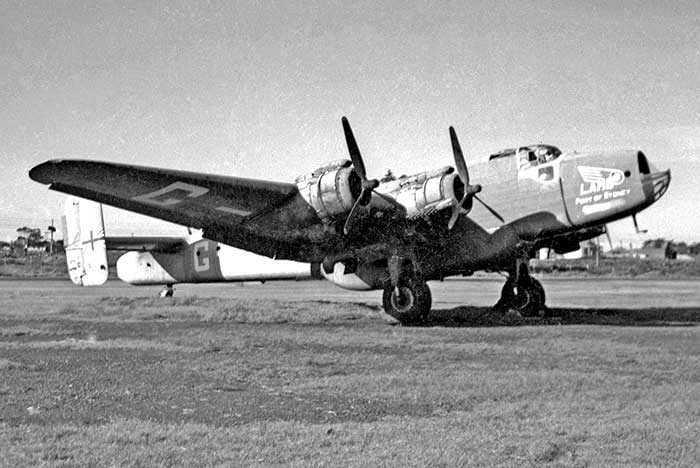
Photo: John Hopton Collection
Royal Air Force
At least two RAF Halifax transports are known to have visited Australia
Halifax B.VI RG815 Mercury:
Operated by RAF Empire Radio School, RG815 departed RAF Debden on 18 September 1946 on a mission to liaise with RAF radio units between Britain and New Zealand and demonstrate the latest advances in radio comminications. The aircraft was fitted out for training on a range of airborne radio and radar equipment. It stopped at RAF stations in Palestine, Iraq, India, Burma, Singapore before spending 3 weeks in Australia.
23.10.46 Arrived at Ohakea RNZAF Station from Australia. Ohakea-Auckland 25.10.46, to Wigram 29.10.46, to Ohakea 31.10.46.
1.11.46 Departed Ohakea for Melbourne, under command Flt Lt R. E. Harrison. Returned to Ohakea due engine shut down
3.11.46 Departed Ohakea again for Melbourne, Singapore and Britain
Operated by RAF Empire Radio School, RG815 departed RAF Debden on 18 September 1946 on a mission to liaise with RAF radio units between Britain and New Zealand and demonstrate the latest advances in radio comminications. The aircraft was fitted out for training on a range of airborne radio and radar equipment. It stopped at RAF stations in Palestine, Iraq, India, Burma, Singapore before spending 3 weeks in Australia.
23.10.46 Arrived at Ohakea RNZAF Station from Australia. Ohakea-Auckland 25.10.46, to Wigram 29.10.46, to Ohakea 31.10.46.
1.11.46 Departed Ohakea for Melbourne, under command Flt Lt R. E. Harrison. Returned to Ohakea due engine shut down
3.11.46 Departed Ohakea again for Melbourne, Singapore and Britain
Operated by No.301 (Polish) Squadron based at RAF Chedburgh, Suffolk. Visited Australia during December 1946 on a long range Far East mission.
This aircraft's RAF record card states it was loaned to BOAC effective 26.9.45. No mention of the visit can be found in Australian newspapers of the time.
Thanks to Polish researcher Mieszko Syski, this page from Navigator F/Sgt Eugeniusz Melchert's logbook shows the Australian section of the flight. Flying hours are in the two right columns, night flying hours in red. Of interest is Melbourne-Darwin 8 hrs 20 minutes on Christmas Eve.
Christmas Day in Darwin must have been an experience for the aircraft's Polish crew.
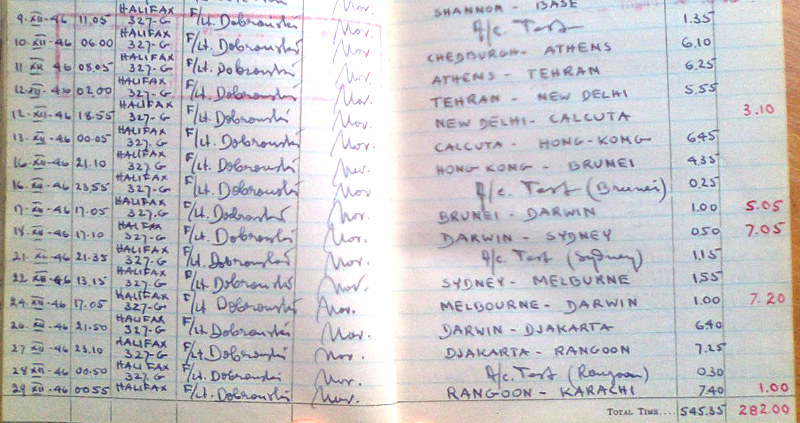
44 Australian pilot with 466 Squadron, RAF Bomber Command
7.5.44 His Halifax LV943 HD-G was shot down by Luftwaffe fighters over France, all 10 crew parachuted safely.
24.6.44 Reached England 24.6.44 after hiding and travelling through France and Spain to Gibralta
3.47 Joined Aircarriers Pty Ltd at Sydney as pilot of their Halifax VH-BDT.
6-7.47 Flew VH-BDT from Sydney to Singapore and return. Last flight of the aircraft and company wound up.
c9.47 Joined LAMS (Australia) Pty Ltd Sydney as their first Australian pilot. Sent to England on board a visiting LAMS Halifax to familiarise himself
with their operations. Crewed Halifax flights between England and South Africa
.48 Stranded in England when LAMS collapsed
4.48 Pilot of DH.89 Rapide VH-BKM on delivery flight from England to Alice Springs NT for Connellan Airways, accompanied by
another DH.89 VH-BKR flown by Damian Miller. Hourigan took the ferry job to get home to Australia
6.5.48 Hourigan's Rapide lost engine power on takeoff at Daly Waters NT on the final leg to Alice Springs and Hourigan made a forced
landing in a clearing, crashed and aircraft burst into flames. Hourigan was pulled unconscious from the wreckage with a broken leg
by passenger, aircraft engineer Jim Crombie, who also moved the other two passengers from the burning aircraft.
Ted Hourigan went on to fly for ANA, BCPA and Qantas, retiring on Boeing 707s
Keith F. "Jimmy" Thiele, DSO, DFC and 2 bars
6.41 New Zealander who enlisted in RNZAF and sent to Britain 6.41 with RAF Bomber Command. Flew 50 missions in Wellington, Halifax and
Lancaster bombers. Survived a runway collision, flak damage and a forced landing in a crippled Lancaster
2.44 Transferred to RAF Fighter Command, flew Spitfires, Tempests and Typhoons
10.2.45 His Tempest was shot down by flak over Germany, baled out and taken prisoner. Later escaped from a German POW camp.
2.47 Appointed LAMS Chief Pilot at Stansted, England
23.4.47 Thiele departed Stansted in a LAMS Halifax on the first around-the-world freight tramping flight via Canada, USA, Hawaii, NZ, Australia,
Singapore, India. Returned to Stansted 4.6.47
11.47 Flew a LAMS Halifax from England to Sydney, to take over LAMS (Australia) Pty Ltd as Manager and Chief Pilot
15.1.48 Last flight of a LAMS Halifax at Sydney.
1.48 In Sydney resigned from LAMS when the company in England floundered due to the illness of its founder Dr. Graham Humby
Keith Thiele went on to a long career with Qantas, retiring on Boeing 707s
- Australian Civil Aircraft Register, Department of Civil Aviation
- National Archives of Australia - DCA files G-AGXA and VH-BDT
- National Archives of Australia - DCA file LAMS Ltd - NSW Region NAA B596.7
- National Archives of Australia - Bankruptcy Court hearing H.W.G.Penny July 1949 - references to Aircarriers Pty Ltd
- National Archives of Australia - Commonwealth Disposals Commission file: sale of Hercules engine to Aircarriers Pty Ltd
- National Library of Australia - Trove website newspaper archive
- NSW State Records Office: Defunct Companies: Aircarriers Pty Ltd: file extracts by Chris O’Neil, Nov 2000
- British Civil Aircraft Register: g-info website
- Flypast A Record of Aviation in Australia, Neville Parnell & Trevor Broughton, CAA 1988
- British Civil Aircraft Since 1919, A. J. Jackson, Vol 2, Putnam London, 1973
- The Civil Halifax and Halton, Derek King, Air Britain Aviation World, issues June 2016 and September 2016
- British Military Aircraft Serials 1911-1979, Bruce Robertson, Patrick Stephens 1979
- Elstree LAMS, Wingspan magazine
- Flight of the Halifax, Geoffrey Wikner, published by K.V.Wikner, Sydney 1993
- Humping The Blue in Waltzing Matilda, Geoffrey Wikner, Aeroplane Monthy, September 1979
- Air Britain Archive journal: pages 83/48. 94/22, 94/50, 94/75. 94/107
- Aircraft Visiting New Zealand 1940 to 1948: AHSNZ Journal, June 1970
- The Halifax in New Zealand, Brian L. Lockstone, AHSNZ Journal, July 1970
- Geoffrey Wikner, letter, Aviation Heritage, Aviation Historical Society of Australia, Vol.22 No.3
- From Bomber to Tramp, J. Stubbs Walker, Air Transportation magazine, October 1947
- Halibags in Mufti, Brian Turpin, Aeroplane Monthly magazine, May 1975
- London Aero and Motor Services, Aviation News magazine, August 2004